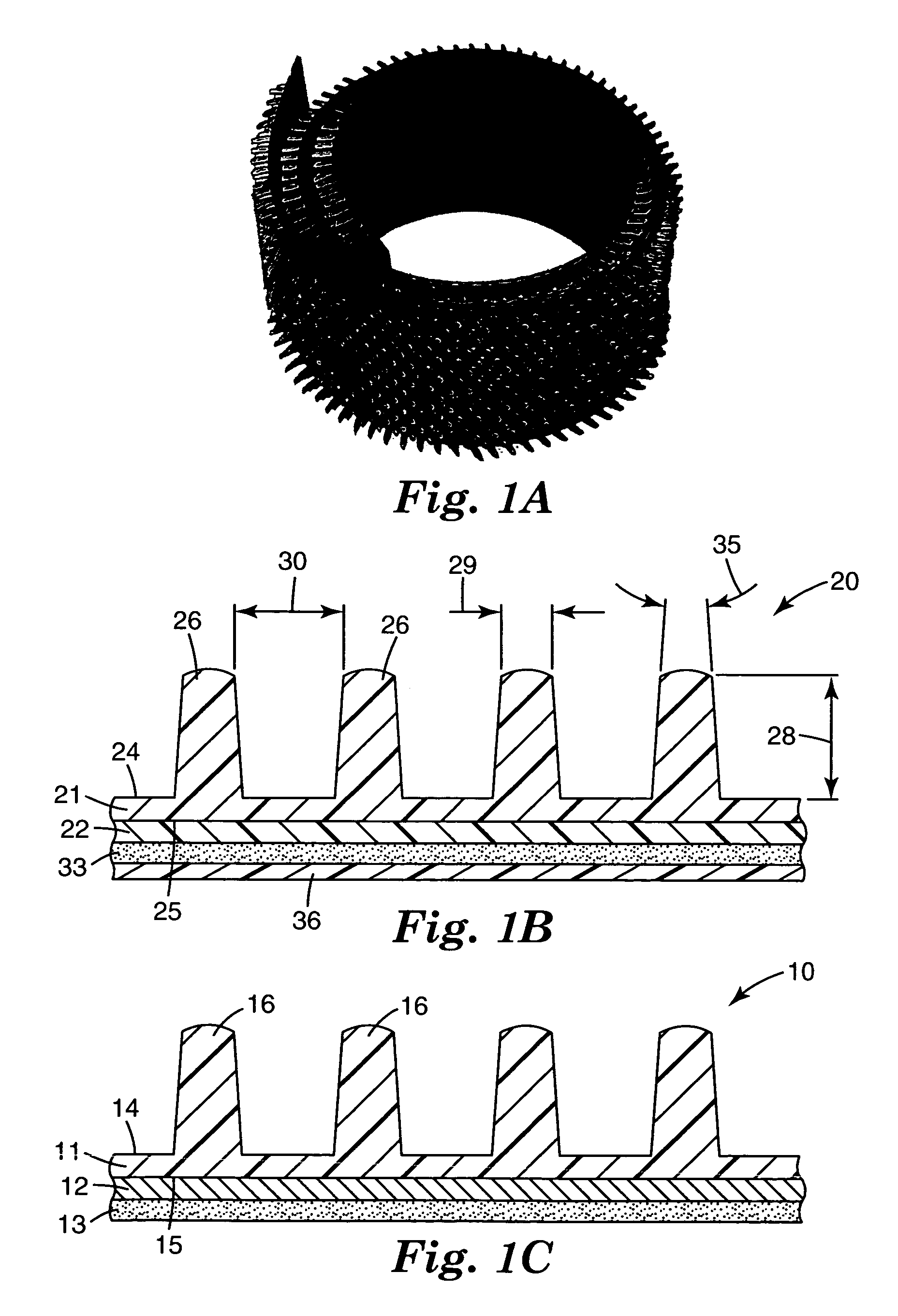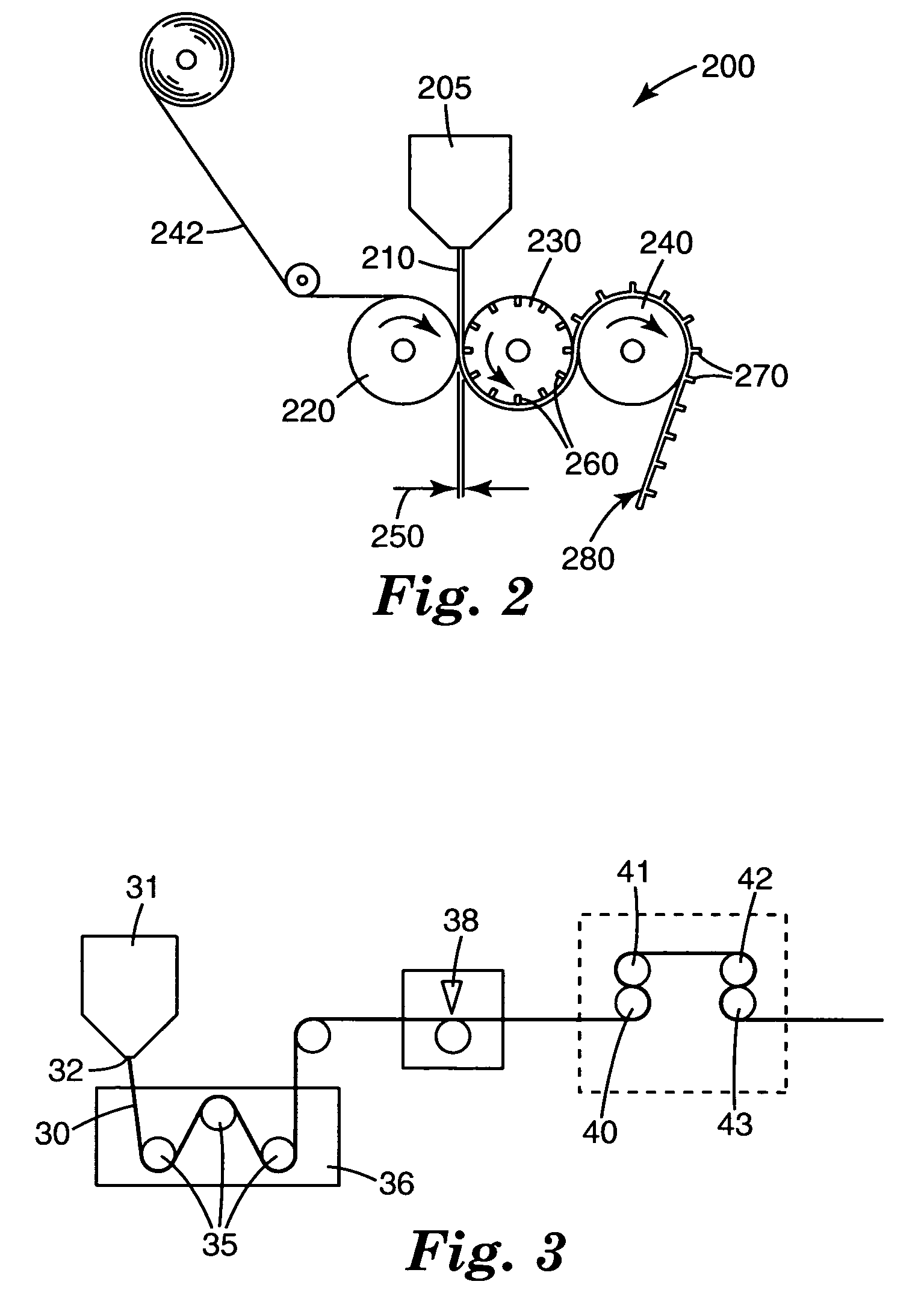Flexible heat sink
a heat sink and flexible technology, applied in the direction of laminated elements, lighting and heating apparatus, semiconductor/solid-state device details, etc., can solve problems such as electromagnetic interference problems in electronic devices, and achieve the effects of reducing noise transmission, reducing shock and vibration of components and/or the larger surface structure, and reducing the flexibility of the heat sink
- Summary
- Abstract
- Description
- Claims
- Application Information
AI Technical Summary
Benefits of technology
Problems solved by technology
Method used
Image
Examples
example 1
[0106]A flexible heat sink article was prepared using a process and apparatus such as illustrated in FIG. 2.
[0107]Pellets of Polymer A were fed into a single screw extruder (Model KTS-125 available from Killion Extruders, Inc. of Cedar Grove, N.J.) and melt-processed. The extruder had a diameter of about 3.2 cm (1.25 in), a screw speed of 80 rpm and a rising temperature profile from about 100° C. up to approximately 250° C. The Polymer A resin was conveyed through the extruder into a heated neck tube at 250° C. and finally into a 250° C. heated 15.2 cm (6 inches) wide sheet die with a maximum die lip opening of 0.102 cm (0.040 inch). The resin was continuously discharged from the sheet die at a pressure of 17.2 MPa (2500 psi) to form a molten polymer sheet.
[0108]Referring now to FIG. 2, molten polymer sheet 210 formed as described above 15 was introduced into nip 212 between nip roll 220 and cast roll 230 of a horizontal stack of three temperature-controlled, rotating, 30.5 cm (12 i...
example 2
[0112]Two flexible heat sink articles (2A and 2B) as shown in FIG. 7 were prepared by melt replication from Polymer C and Polymer D using a silicone mold.
[0113]The silicone mold used to produce heat sink article as shown in FIG. 7 was prepared by casting Silicone Resin onto a commercially available aluminum heat sink. The resin was allowed to cure overnight at room temperature and the cured resin was removed from the heat sink to provide a silicone mold.
[0114]One or two 1.18 cm (3 inches) long by 1.18 cm (3 inches) wide by 0.32 cm (⅛ inch) thick plaques of either Polymer C (to make heat sink article 2A) or Polymer D (to make heat sink article 2B) were aligned on the mold, then sandwiched between silicone coated paper liners, and melt pressed at 190° C. (374° F.) and a pressure of 454.5 kg (0.5 tons) for about 10 seconds followed by quenching on a cold press for 30 seconds. A thin layer of mold release agent was sometimes applied to the surface of silicone mold prior to melt pressing...
example 3
[0117]A heat sink article as shown in FIG. 8 was prepared as in Example 2, using a silicone mold and Polymer C. The silicone mold was prepared from a commercially available aluminum heat sink.
[0118]The resultant heat sink article had a square matrix design of polymeric protrusions that were tapered on one side. The width of the tapered side of the protrusion was about 1.6 mm (0.63 inch) at the top and about 2.2 mm (0.87 inch) at the point where the projection joined the base. The width of the straight side of the protrusion was about 2.5 mm (0.098 inch). The height of each projection was about 9 mm (0.35 inch) and the center-to-center spacing of the projections was about 5 mm (0.2 inch). The thickness of the heat sink article base was about 1.7 mm (0.067 inch).
[0119]The heat sink article was tested for cooling performance and wet-out capability on a concave surface with 9882 adhesive. The wet-out capability was lower than later samples because the base surface of this early prototyp...
PUM
| Property | Measurement | Unit |
|---|---|---|
| flexural modulus | aaaaa | aaaaa |
| aspect ratio | aaaaa | aaaaa |
| heights | aaaaa | aaaaa |
Abstract
Description
Claims
Application Information
 Login to View More
Login to View More - R&D
- Intellectual Property
- Life Sciences
- Materials
- Tech Scout
- Unparalleled Data Quality
- Higher Quality Content
- 60% Fewer Hallucinations
Browse by: Latest US Patents, China's latest patents, Technical Efficacy Thesaurus, Application Domain, Technology Topic, Popular Technical Reports.
© 2025 PatSnap. All rights reserved.Legal|Privacy policy|Modern Slavery Act Transparency Statement|Sitemap|About US| Contact US: help@patsnap.com



